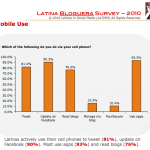Offline WOM More Prevalent, Positive and Credible than Online Buzz
Word-of-mouth (WOM) conversations that take place in person and over the phone are overwhelmingly more prevalent than those online, according to research.
Also, face-to-face communication is more positive in tone, more likely to be judged highly credible and more likely to lead to strong purchase intent than online talk, the study found
Below, some of the findings issued
On average, 3.5 billion WOM conversations occur daily in the US. Offline WOM accounts for 92% of these (75% face to face; 17% by phone), and email, IM/text messaging and chatrooms/blogs account for a combined 7%:
Also:
- Offline is the predominant mode of WOM across all age groups, ranging from 80% among the youngest group to 97% among the oldest
- However, teens participate in a higher percentage of online WOM (17%) than members of other age groups.
- Consumers under age 18 are also more likely than others to drive advice-giving in online talk. Though only 13% of offline advice-givers are age 13-17, 35% of advice givers in online conversations fall within that age bracket.
- WOM expressed face to face and by phone also is viewed as highly “credible” more often than online talk (59% vs. 49%):
One possible explanation for the credibility gap is that online communications often occur between people who don’t know each other very well. But the study suggests that the credibility gap exists even in communications between people who are related or otherwise know each other.
Specifically, content from a spouse, relative or best friend is rated more believable when it is shared offline, either by phone or face to face, than online – via email, text messaging or blogs.
“Apparently, the value of eye contact, voice and perhaps even nonverbal communication provides a boost to credibility and to the likelihood that we’ll do something about what we’ve learned,” said Brad Fay, a coauthor of the study.
Other findings:
- Offline communication has more purely positive content than online discussion (65% vs. 59%) and is less likely to contain negative or “mixed” content (23% vs. 30%).
- A comparison between face-to-face communication and content on online blogs and chatrooms reveals an ever wider gap, with 66% of face-to-face communication “mostly positive” compared with 57% for blogs/chatrooms.
- Offline WOM is more likely than its online counterpart to lead to strong purchase intent (50% vs. 43%).
About the study: Results of the Keller Fay/OMD study are based primarily on surveys of 18,486 Americans age 13-69, from late July 2007 through early February 2008.












Leave a Reply
Want to join the discussion?Feel free to contribute!